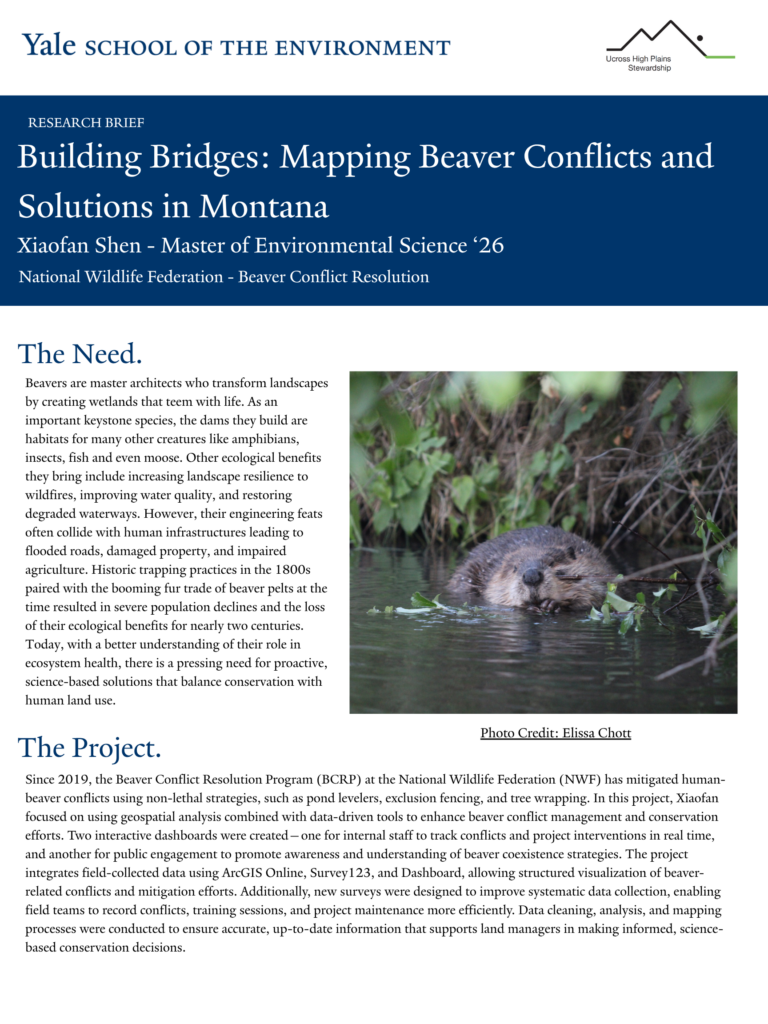
Building Bridges: Mapping Beaver Conflicts and Solutions in Montana
Xiaofan focused on using geospatial analysis combined with data-driven tools to enhance beaver conflict management and conservation efforts. Two interactive dashboards were created—one for internal staff to track conflicts and project interventions in real time, and another for public engagement to promote awareness and understanding of beaver coexistence strategies. The project integrates field-collected data using ArcGIS Online, Survey123, and Dashboard, allowing structured visualization of beaver-related conflicts and mitigation efforts. Learn more about the project…

Landscape Factors that Influence Habitat Selection and Movement for Pronghorn in Southwestern Montana
Jeremy worked with the National Wildlife Federation (NWF) in Montana to identify, gather, and create publicly available biologically-relevant landscape-level GIS layers for pronghorn in southwestern Montana, which will be used with pronghorn GPS location data in movement models to help understand habitat use during their migration. Learn more about the project…
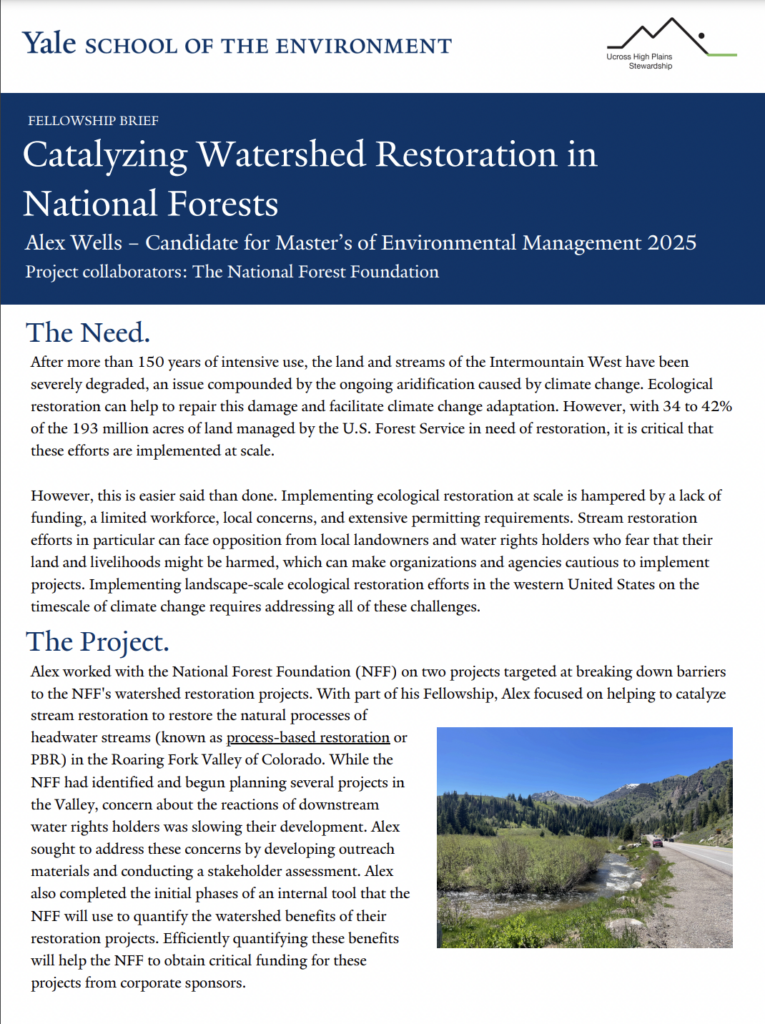
Catalyzing Watershed Restoration in National Forests
Alex worked with the National Forest Foundation (NFF) on two projects targeted at breaking down barriers
to the NFF’s watershed restoration projects. With part of his Fellowship, Alex focused on helping to catalyze
stream restoration to restore the natural processes of
headwater streams (known as process-based restoration or
PBR) in the Roaring Fork Valley of Colorado. While the
NFF had identified and begun planning several projects in
the Valley, concern about the reactions of downstream
water rights holders was slowing their development. Learn more about the project…

Documenting How Outdoor Recreation Influences Stream Ecosystem Components in Northern Utah—Joshua Kesling
(2024) Joshua deployed field experiments along a tributary flowing from headwaters in the Uinta-Wasatch-Cache National Forest to the Jordan River, situated in a suburban environment. Along Big Cottonwood Creek in Utah, his research orbited around assessing how outdoor recreation patterns and activities influenced stream and riparian attributes. Through individual and group-level observational work, Joshua carefully studied recreational patterns, plant and wildlife composition, and shoreline intactness at eight field sites along the entirety of Big Cottonwood Creek. Learn more about the project…

Working with People and Data to Address Climate Change in King County, WA—Ingrid Thyr
(2024) Ingrid’s work supported three ongoing projects within the Executive Climate Office (ECO) related to data and community engagement. This included researching online platform options for a future King County climate dashboard that will display priority indicators and climate actions happening within the county. This process included interviews with team members regarding needs and desires as well as interviews with other departments and governments around the country about their own dashboards. Learn more about the project…

Nuclear and Renewable Energy in the American West—Aya Ochiai
(2024) Aya conducted archival research at several Idaho universities and at the National Archives. Records she studied included publications from the Atomic Energy Commission/Department of Energy, papers of Idaho senators, and local newspapers. She also interviewed former employees of INL and other community members. Aya also worked at NREL as a mechanical engineering intern and worked on a novel floating tidal turbine design. She iteratively designed and simulated systems to lift parts of the turbine out of water for maintenance and to support it under operational conditions. Learn more about the project…

Patterns of Productivity and Radiation Use Efficiency in the Upper Green River Basin—Sam Wilson
(2023) Sam selected a study site that would allow him to capture a wide range in environmental variables (precipitation, temperature, grazing intensity, soil texture) and vegetative variables (shrub density, species composition) while remaining within a big sagebrush ecosystem. He selected the Upper Green River Basin in western Wyoming because it has large variability in all the variables listed above and is almost entirely public lands. Within the basin, Sam randomly selected 80 plots and then collected biomass samples from each plot during summer 2023. Samples were weighed and then this value was used it to calculate herbaceous biomass and radiation use efficiency of each plot. Learn more about the project…

Assessing big sagebrush plant community recovery on natural gas well pads in southwestern Wyoming—Damaris Chenoweth
(2023) This study consisted of three phases: (1) plant community data collection, (2) restoration data collection, and (3) simulation modeling. Damaris’s work as a Western Resources Fellow during the summer of 2023 comprised the first phase. Damaris surveyed areas that had been disturbed by natural gas (i.e. well pads) 14-27 years ago, were restored and seeded, and are now in various stages of recovery. She assessed plant community composition and structure along transects that crossed over the edges of the disturbances to describe the disturbed plant communities and their undisturbed counterparts. She collected soil samples to characterize the species composition of seeds that were present in the surface soils (i.e. the seed bank). Learn more about the project…

Soil greenhouse gas exchange along a temperature gradient in the North American Central Grasslands—Uthara Vengrai
(2023) This study investigated whether there are differences in soil greenhouse gas fluxes and carbon storage in semi-arid temperate grasslands, which are functionally similar except for having different temperature regimes. Uthara hypothesized that at sites with higher mean annual temperatures, there would be larger carbon dioxide emissions, nitrous oxide emissions, and methane uptake because microbial biochemical processes happen faster at higher temperatures, and that soil carbon would be lowest because rates of plant productivity are similar across sites, but decomposition will be slower at colder sites. To test this, Uthara took greenhouse gas flux measurements and soil samples at sites in Texas, New Mexico, Colorado, Wyoming and Montana, which created a latitudinal gradient along the western edge of the North American Central Grasslands. Learn more about the project…

Imagining an Agricultural Future: Collective Water Management in the San Luis Valley, Colorado—Kathleen Voight
(2023) During the summer of 2023, Kathleen conducted over 100 hours of participant observation, a research methodology wherein the researcher is immersed in the lives of the participants. Kathleen attended basin roundtables, community meetings, political events, conferences, board meetings, workshops, auctions, and fairs. She conducted 30 semi-structured interviews with water users and water managers, each one to five hours long. She spoke with farmers and ranchers, non-profit leaders, elected officials, and government representatives. The interviews happened at kitchen tables and on back porches, in pick-up trucks and in fields, while hauling hay or moving cattle. Learn more about the project…

From Fields to Future: A Multispecies Ethnography of Regenerative Farmers’ Experiences of Climate Change—Julia Jacobson
(2023) Julia’s fieldwork took place across the three river basins of southwest Colorado, the Gunnison, Rio Grande, and San Juan. The town of Gunnison is home to Julia, so she came to this research with established relationships in the field and a vested interest in the agricultural future of the region. Julia’s methodology was rooted in multispecies ethnography, which is a form of research and writing that is attuned to the interdependence of human and non-human life. Multispecies ethnography challenges Western epistemologies to think beyond anthropocentric human/nature binaries, which often structure exploitative relationships to nature, and position humans as not only apart from nature, but above it. Julia conducted 16 semi structured interviews, and five unstructured interviews. Learn more about the project…

Developing CCALT’s Agricultural Resiliency Fund: Enhancing Ecological Values and Agricultural Viability on Colorado Rangelands—Kathleen Voight
(2023) Kathleen’s work built upon the research completed by a group of UHPSI research assistants who previously worked with CCALT and recommended identifying priorities within CCALT’s Additive Conservation program prior to establishing the ARF. To support this recommendation, Kathleen conducted interviews with the five Additive Conservation subcommittee members of CCALT’s Board of Directors to identify priorities for the program, which then informed funding priorities for the ARF. With funding priorities identified, Kathleen created multiple documents that CCALT will use to establish and implement the ARF. Learn more about the project…
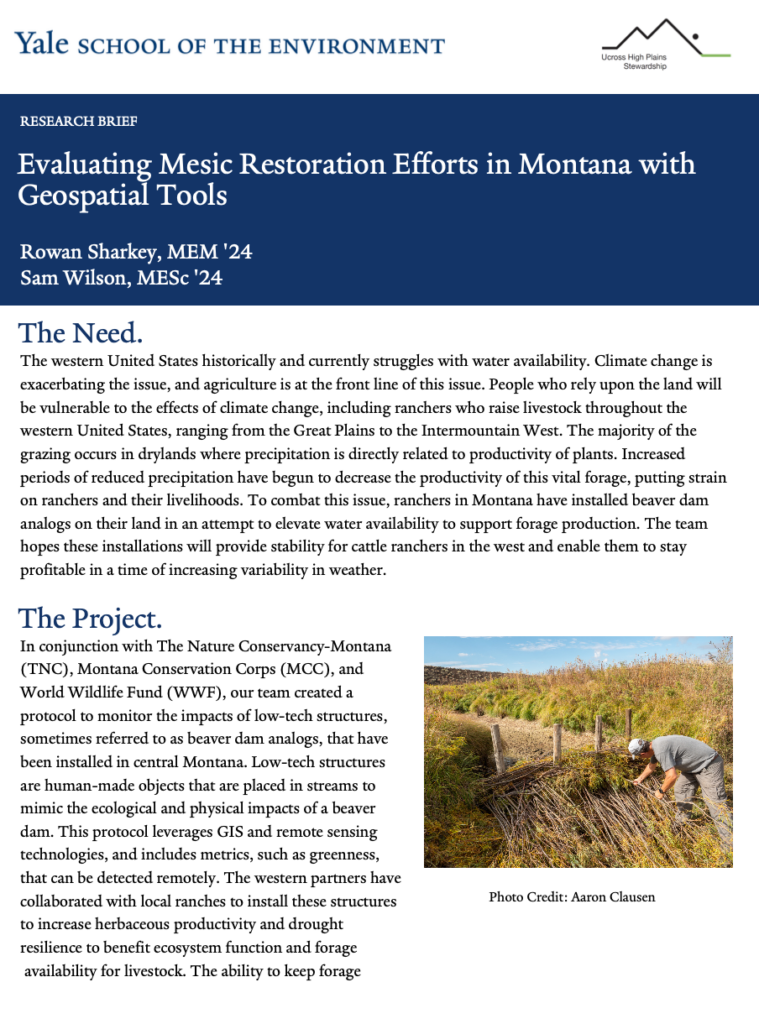
Evaluating Mesic restoration Efforts in Montana with Geospatial Tools—Rowan and Sam
(2023) In conjunction with The Nature Conservancy-Montana (TNC), Montana Conservation Corps (MCC), and World Wildlife Fund (WWF), our team is creating a protocol to evaluate the impacts of low-tech structures, sometimes referred to as beaver dam analogs, that have been installed in central Montana. This protocol will leverage GIS and remote sensing technologies, challenging our team to identify metrics that can be detected remotely to aid in understanding the impact of these projects. Low-tech structures are human-made objects that are placed in streams to mimic the ecological and physical impacts of a beaver dam. Learn more about the project…
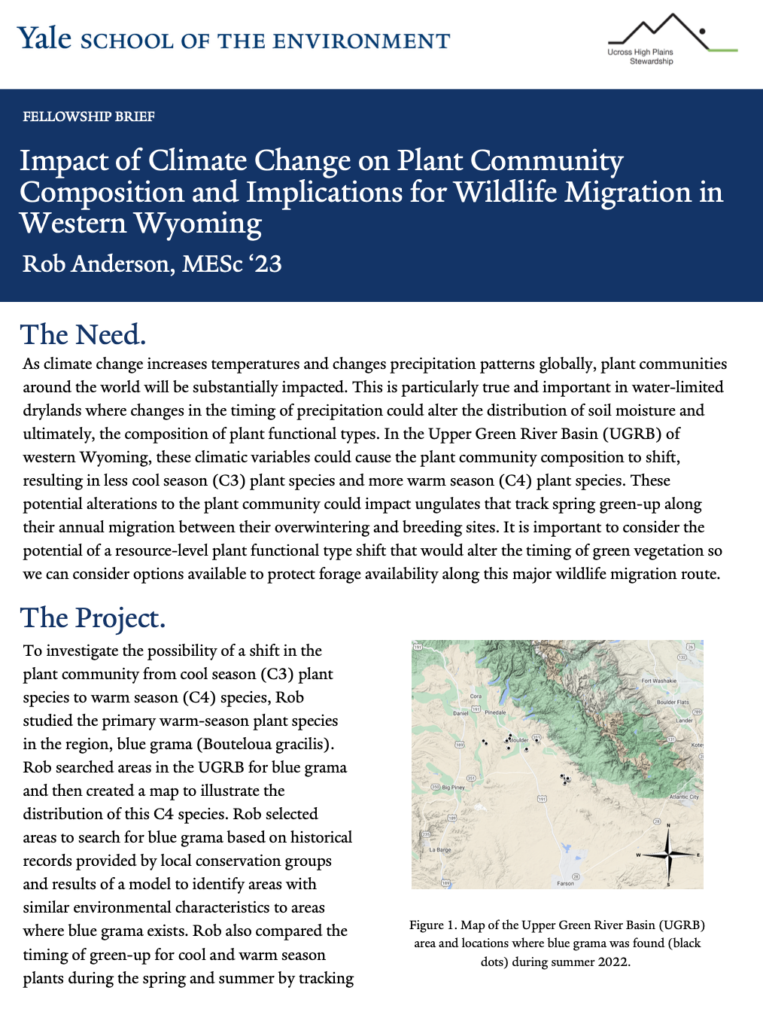
Impact of Climate Change on Plant Community Composition and Implications for Wildlife Migration in Western Wyoming—Rob Anderson
(2022) As climate change increases temperatures and changes precipitation patterns globally, plant communities around the world will be substantially impacted. This is particularly true and important in water-limited drylands where changes in the timing of precipitation could alter the distribution of soil moisture and ultimately, the composition of plant functional types. To investigate the possibility of a shift in the plant community from cool season (C3) plant species to warm season (C4) species, Rob studied the primary warm-season plant species in the region, blue grama (Bouteloua gracilis). Learn more about the project…
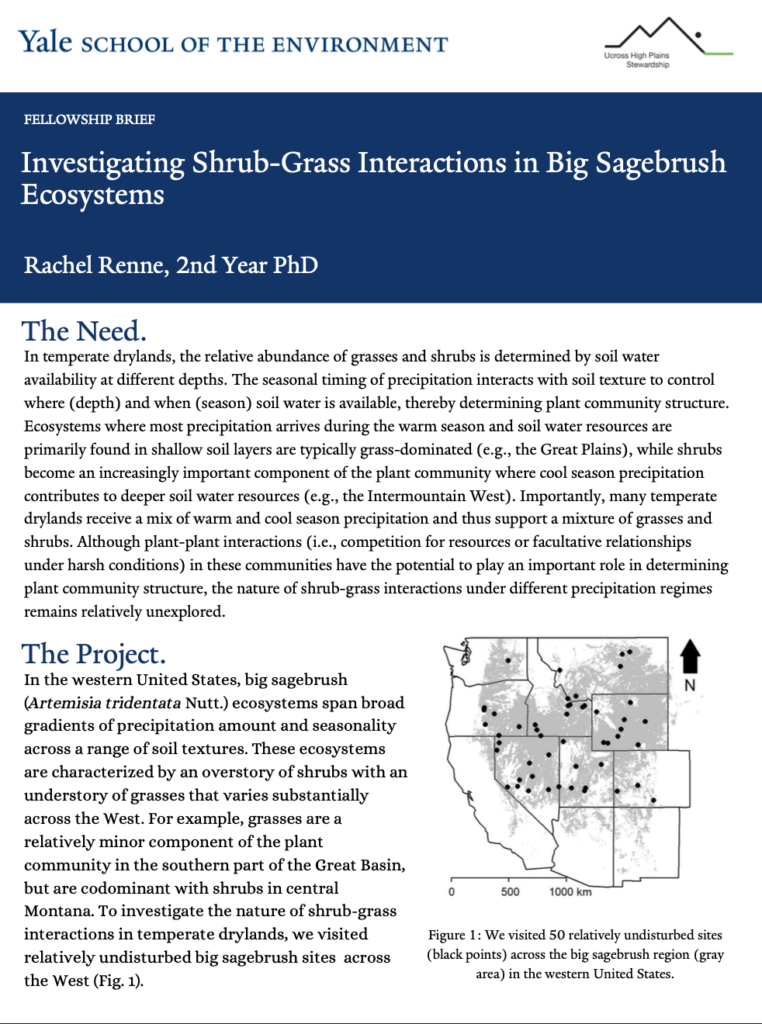
Investigating Shrub-Grass Interactions in Big Sagebrush Ecosystems—Rachel Renne
(2022) In temperate drylands, the relative abundance of grasses and shrubs is determined by soil water availability at different depths. The seasonal timing of precipitation interacts with soil texture to control where (depth) and when (season) soil water is available, thereby determining plant community structure. This project investigates how resource partitioning influences coexistence, competition, and plant functional type composition in temperate drylands. Learn more about the project…

Outdoor Recreation Industry Discourse and Values: Implications for Public Lands—Mara MacDonell
(2022) The outdoor recreation industry in the United States is an estimated 689 billion-dollar industry built on myths of manifest destiny and privilege—and currently positioned as an economic panacea for former extraction communities across the West. As the outdoor recreation boom facilitates rapid growth in rural communities in the West, more questions arise. Learn more about the project…
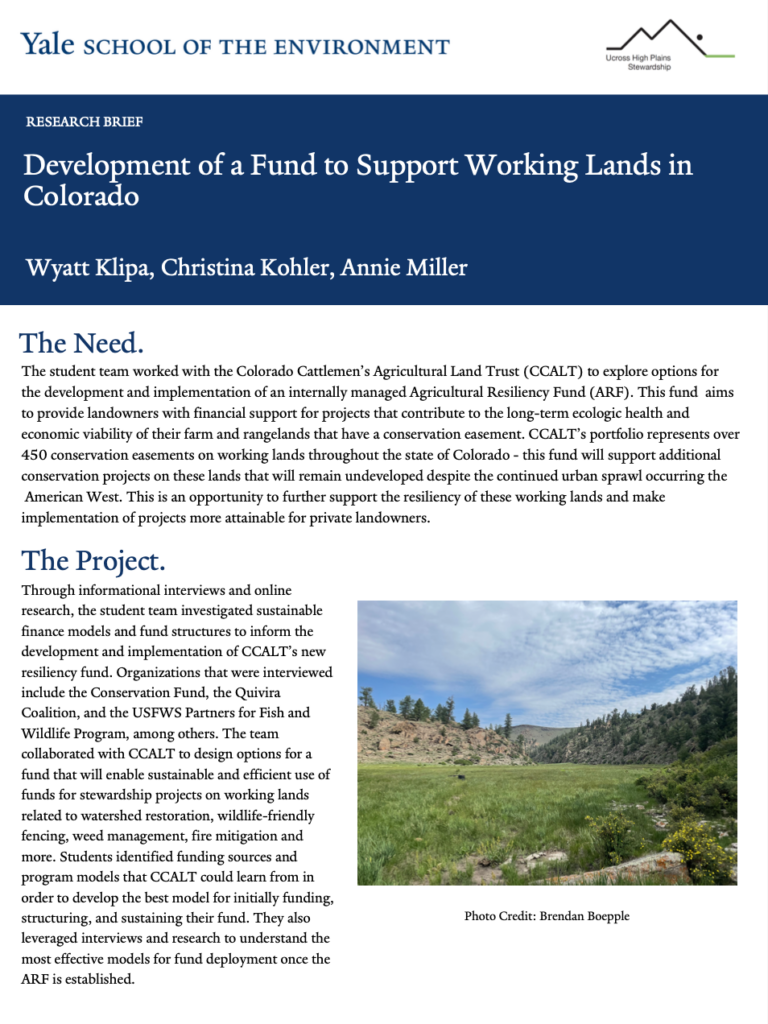
Development of a Fund to Support Working Lands in Colorado —Wyatt Klipa, Christina Kohler, Annie Miller
(2022) Through informational interviews and online research, the student team investigated sustainable finance models and fund structures to inform the development and implementation of CCALT’s new resiliency fund. Organizations that were interviewed include the Conservation Fund, the Quivira Coalition, and the USFWS Partners for Fish and Wildlife Program, among others. Learn more about the project…
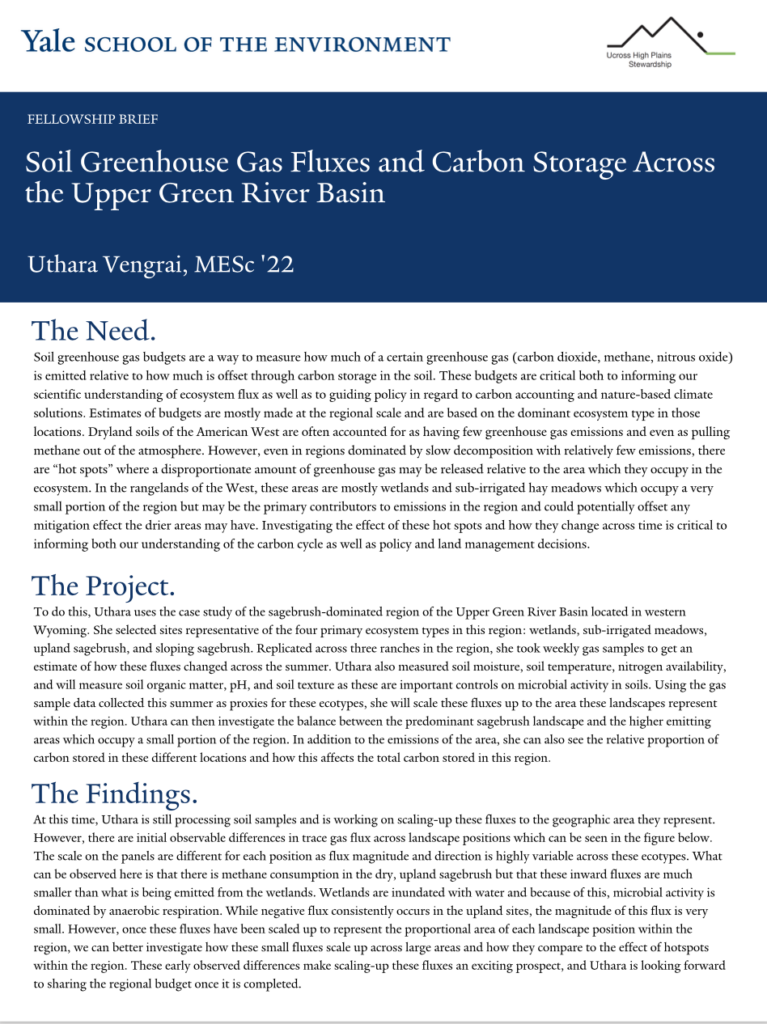
Soil Greenhouse Gas Fluxes and Carbon Storage Across the Upper Green River Basin—Uthara Vengrai
(2021) Uthara uses the case study of the sagebrush-dominated region of the Upper Green River Basin located in western Wyoming. She selected sites representative of the four primary ecosystem types in this region: wetlands, sub-irrigated meadows, upland sagebrush, and sloping sagebrush. Learn more about the project…

“Sin Agua, No Hay Vida”: Exploring Threats to San Luis Valley, Colorado Water Supply—Cloe Dickson
(2021) Cloe Dickson used qualitative research methods, interviews and participant observation, as well as archival resources and discourse analysis. Learn more about the project…

Impacts of Climate Change on Sagebrush Plant Communities Under Variable Grazing Pressures — Scott Carpenter
(2021) Scott’s research examines the relationship between precipitation patterns and grazing by studying grazing intensity gradients created around livestock water sources in southwest Wyoming. Learn more about the project…
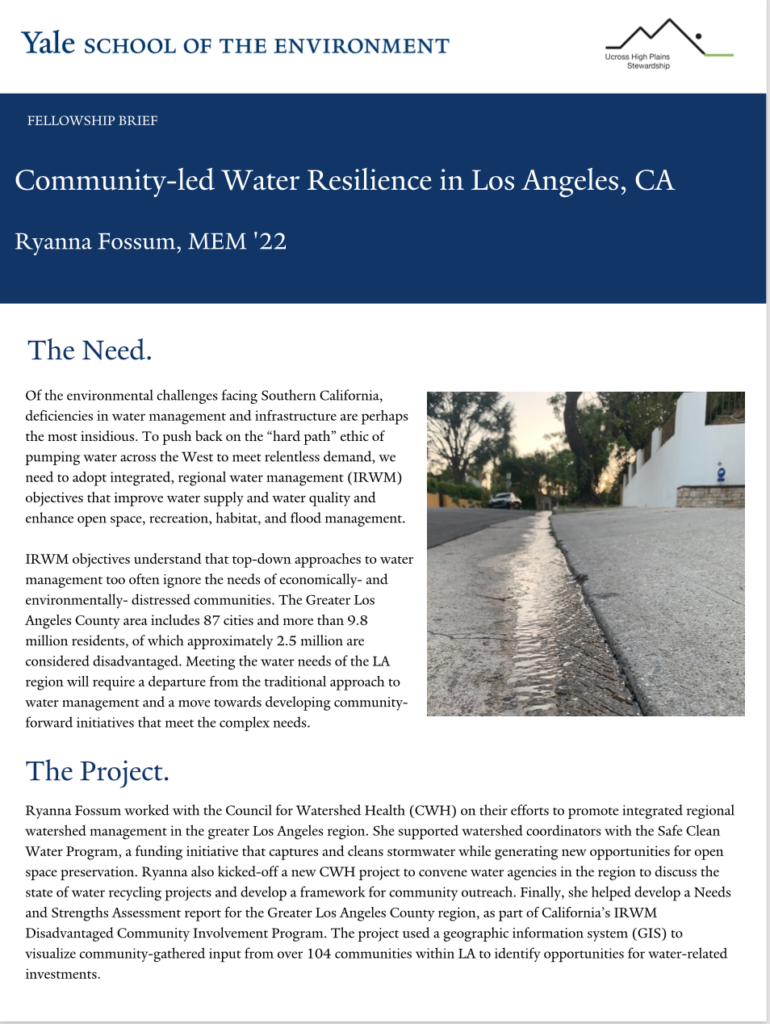
Community-led Water Resilience in Los Angeles, CA — Ryanna Fossum
(2021) Ryanna Fossum worked with the Council for Watershed Health (CWH) on their efforts to promote integrated regional watershed management in the greater Los Angeles region. Learn more about the project…
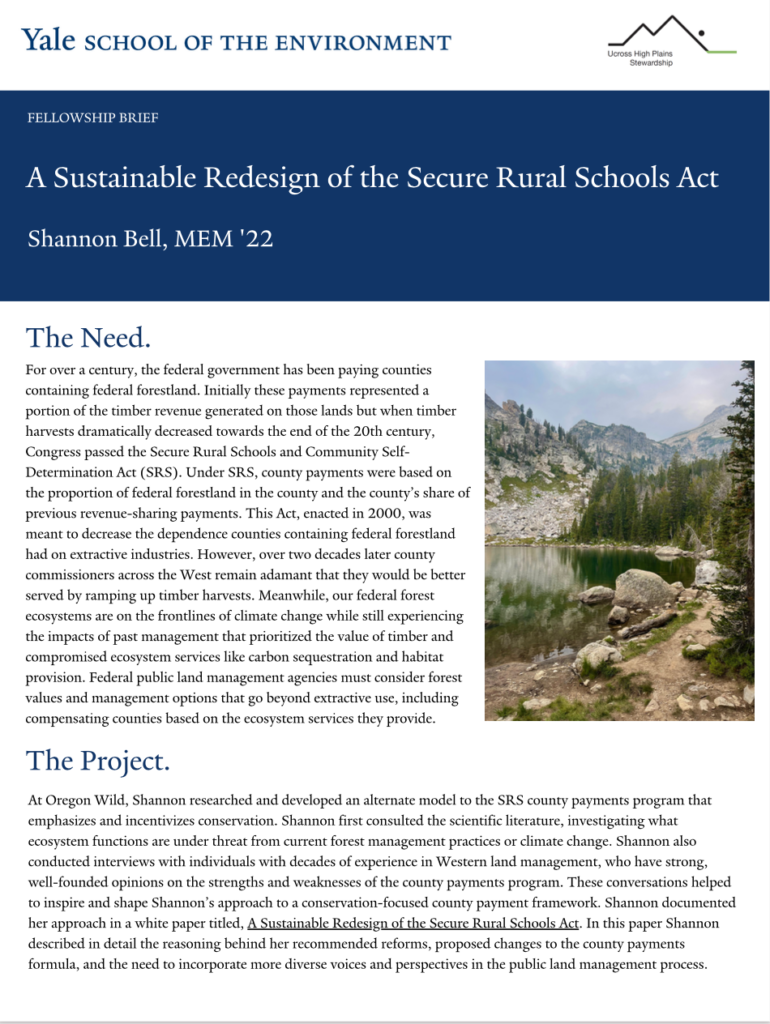
A Sustainable Redesign of the Secure Rural Schools Act — Shannon Bell
(2021) At Oregon Wild, Shannon researched and developed an alternate model to the SRS county payments program that emphasizes and incentivizes conservation. Learn more about the project…

Large-Scale Organic Farming in Montana’s Great Plains: Vilicus Farms — Tim Ibbotson-Sindelar
(2020) Tim immersed himself in daily life at Vilicus Farms, a 9,600-acre organic, dryland, grain, pulse and oilseed farm near Havre, Montana. Learn more about the project…

Managing the Yampa River in a Changing Climate — Humna Sharif
(2020) Humna Sharif worked with the National Parks Conservation Association (NPCA) to understand climate change and management policy impacts on freshwater resources that support national park units. Learn more about the project…
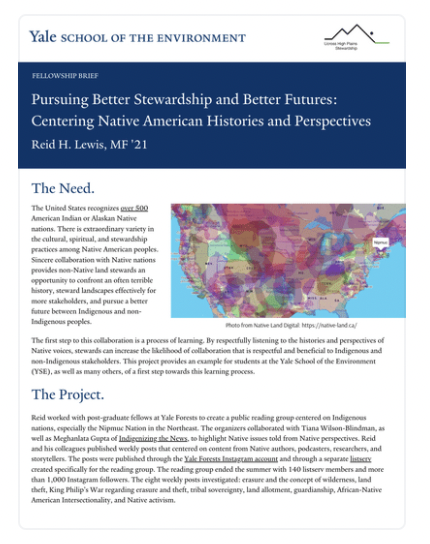
Pursuing Better Stewardship and Better Futures: Centering Native American Histories and Perspectives — Reid Lewis
(2020) Reid worked with post-graduate fellows at Yale Forests to create a public reading group centered on Indigenous nations, especially the Nipmuc Nation in the Northeast. Learn more about the project…
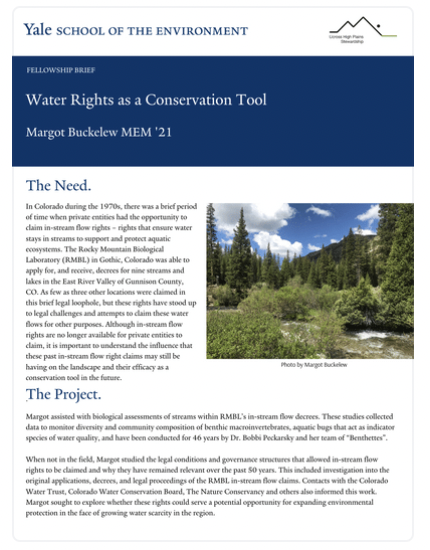
Water Rights as a Conservation Tool — Margot Buckelew
(2020) Margot assisted with biological assessments of streams within RMBL’s in-stream flow decrees. These studies collected data to monitor diversity and community composition of benthic macroinvertebrates, aquatic bugs that act as indicator species of water quality. Learn more about the project…
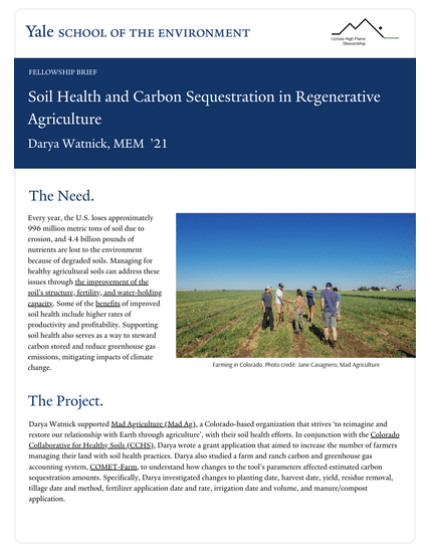
Soil Health and Carbon Sequestration in Regenerative Agriculture — Darya Watnick
(2020) Darya Watnick supported Mad Agriculture (Mad Ag), a Colorado-based organization that strives ‘to reimagine and restore our relationship with Earth through agriculture,’ with their soil health efforts. Learn more about the project…
